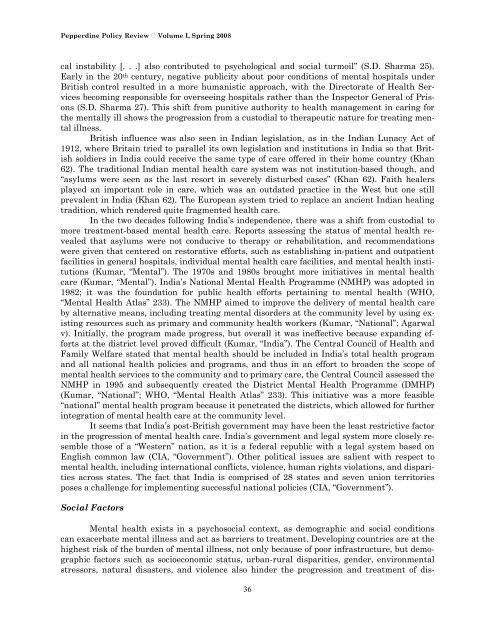Pepperdine University School of Public Policy
Pepperdine University School of Public Policy
Pepperdine University School of Public Policy
You also want an ePaper? Increase the reach of your titles
YUMPU automatically turns print PDFs into web optimized ePapers that Google loves.
<strong>Pepperdine</strong> <strong>Policy</strong> Review Volume I, Spring 2008<br />
cal instability [. . .] also contributed to psychological and social turmoil” (S.D. Sharma 25).<br />
Early in the 20 th century, negative publicity about poor conditions <strong>of</strong> mental hospitals under<br />
British control resulted in a more humanistic approach, with the Directorate <strong>of</strong> Health Services<br />
becoming responsible for overseeing hospitals rather than the Inspector General <strong>of</strong> Prisons<br />
(S.D. Sharma 27). This shift from punitive authority to health management in caring for<br />
the mentally ill shows the progression from a custodial to therapeutic nature for treating mental<br />
illness.<br />
British influence was also seen in Indian legislation, as in the Indian Lunacy Act <strong>of</strong><br />
1912, where Britain tried to parallel its own legislation and institutions in India so that British<br />
soldiers in India could receive the same type <strong>of</strong> care <strong>of</strong>fered in their home country (Khan<br />
62). The traditional Indian mental health care system was not institution-based though, and<br />
“asylums were seen as the last resort in severely disturbed cases” (Khan 62). Faith healers<br />
played an important role in care, which was an outdated practice in the West but one still<br />
prevalent in India (Khan 62). The European system tried to replace an ancient Indian healing<br />
tradition, which rendered quite fragmented health care.<br />
In the two decades following India’s independence, there was a shift from custodial to<br />
more treatment-based mental health care. Reports assessing the status <strong>of</strong> mental health revealed<br />
that asylums were not conducive to therapy or rehabilitation, and recommendations<br />
were given that centered on restorative efforts, such as establishing in-patient and outpatient<br />
facilities in general hospitals, individual mental health care facilities, and mental health institutions<br />
(Kumar, “Mental”). The 1970s and 1980s brought more initiatives in mental health<br />
care (Kumar, “Mental”). India’s National Mental Health Programme (NMHP) was adopted in<br />
1982; it was the foundation for public health efforts pertaining to mental health (WHO,<br />
“Mental Health Atlas” 233). The NMHP aimed to improve the delivery <strong>of</strong> mental health care<br />
by alternative means, including treating mental disorders at the community level by using existing<br />
resources such as primary and community health workers (Kumar, “National”; Agarwal<br />
v). Initially, the program made progress, but overall it was ineffective because expanding efforts<br />
at the district level proved difficult (Kumar, “India”). The Central Council <strong>of</strong> Health and<br />
Family Welfare stated that mental health should be included in India’s total health program<br />
and all national health policies and programs, and thus in an effort to broaden the scope <strong>of</strong><br />
mental health services to the community and to primary care, the Central Council assessed the<br />
NMHP in 1995 and subsequently created the District Mental Health Programme (DMHP)<br />
(Kumar, “National”; WHO, “Mental Health Atlas” 233). This initiative was a more feasible<br />
“national” mental health program because it penetrated the districts, which allowed for further<br />
integration <strong>of</strong> mental health care at the community level.<br />
It seems that India’s post-British government may have been the least restrictive factor<br />
in the progression <strong>of</strong> mental health care. India’s government and legal system more closely resemble<br />
those <strong>of</strong> a “Western” nation, as it is a federal republic with a legal system based on<br />
English common law (CIA, “Government”). Other political issues are salient with respect to<br />
mental health, including international conflicts, violence, human rights violations, and disparities<br />
across states. The fact that India is comprised <strong>of</strong> 28 states and seven union territories<br />
poses a challenge for implementing successful national policies (CIA, “Government”).<br />
Social Factors<br />
Mental health exists in a psychosocial context, as demographic and social conditions<br />
can exacerbate mental illness and act as barriers to treatment. Developing countries are at the<br />
highest risk <strong>of</strong> the burden <strong>of</strong> mental illness, not only because <strong>of</strong> poor infrastructure, but demographic<br />
factors such as socioeconomic status, urban-rural disparities, gender, environmental<br />
stressors, natural disasters, and violence also hinder the progression and treatment <strong>of</strong> dis-<br />
36












